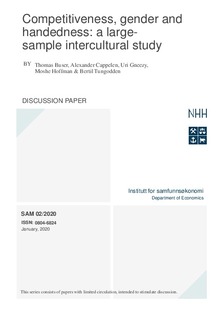Competitiveness, gender and handedness: a large-sample intercultural study
Working paper

Åpne
Permanent lenke
http://hdl.handle.net/11250/2636590Utgivelsesdato
2020-01Metadata
Vis full innførselSamlinger
- Discussion papers (SAM) [649]
Sammendrag
We conduct a large-scale intercultural experiment to elicit competitiveness and ask whether individual and gender differences in competitiveness are partially determined by nature. We use being a “lefty” (i.e., having either a dominant left hand or a dominant left foot) as a proxy for nature, as it is associated with neurological differences which are determined prenatally and reflects a masculinized neurology. That way we use handedness and footedness as a proxy for innate differences. In large-scale data with incentivized choices from 3683 participants from India, Norway and Tanzania, we find a significant gender gap in competitiveness in all cultures. However, we find inconsistent results when comparing the competitiveness of lefties and righties. In northeast India we find that lefties of both genders are significantly more competitive than righties. In Norway we find that lefty men are more competitive than any other group, but women’s competitiveness is not related to handedness or footedness. In Tanzania, we find no effect of handedness or footedness on the competitiveness of either gender. The merged data show weak evidence of a positive correlation between being a lefty and competitiveness for men, but no such evidence for women. Thus, our data do not provide robust evidence that gender differences in competitiveness are partially determined by nature, where nature is represented by the complex, physiologically-rooted phenomenon of handedness.